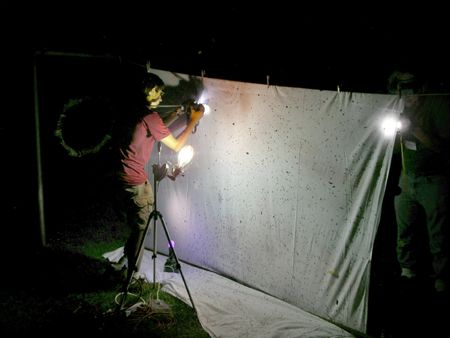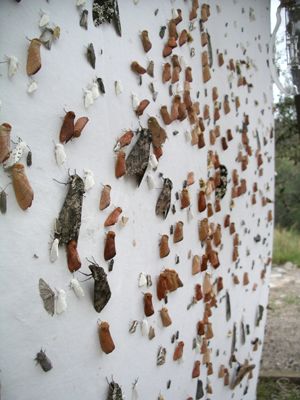
Lucas photographing moths on a light sheet at the BugGuide Gathering in WI, July, 2015
But, like mammals, a significant contingent of insects are nocturnal. The most obvious are the moths. There are well over 2,000 species of lepidoptera known from the Hill Country; only about 150 of those are butterflies. With moth species numbering in the four digits, it would be a shame to ignore them just because I can't find them easily during the day. A typical way that entomologists study biodiversity is to set traps and then see what is collected, but I prefer to see the wildlife, well, alive. Luckily, there is a simple and effective way to have the opportunity to meet the bugs of darkness: using light.
 Lucas photographing moths on a light sheet at the BugGuide Gathering in WI, July, 2015 |
Moths and other nocturnal insects might prefer to hide by day, but during the night many kinds are attracted to intense illumination. Nobody has figured out the definitive reason for this phenomenon, but several theories have been around for some time. The first I remember hearing is that moths evolved with only the moon as a light source and they become confused by the small and bright, but very close, artificial substitutes. Another is that the light simulates dawn at the wrong time and that confuses them. My choice for the most likely to be close to the answer is transverse orientation. Moths flying at night might keep the moon at the same angle at all times in order to travel in a straight line, optimizing their coverage of territory while minimizing the likelihood of inefficiently flying in circles. Moths fly to locate food and mates, so while seeking those, it makes sense to keep trying new territory until the resource is found. It would be a waste of energy to retrace previously covered but unproductive ground. When an artificial light is suddenly encountered, the moth might mistake it for the moon and try to keep it at the same angle. But the angle would change quickly as the insect flies past so it would swerve to correct for that and the end result would be the typical spiraling path so often seen. Once a moth is at a bright light, which could never have happened with the moon, it simply doesn't have a hard-wired reaction to this unique situation. Moths don't think or work things out like vertebrates. They just don't have the brain power. Instead, they have a repertoire of behaviors that usually cover the challenges that they face during their short life spans but don't account for modern technology.
So, to take advantage of insects' penchant for this sort of behavior, whatever the underlying reason, we've developed the use of light sheets. Any kind of light will work as a lure, including a candle, lantern, porch light or campfire. There are, however, much more effective sources. Insects can see in a wider color spectrum than we can, so black lights often work well. Another great tool is the mercury vapor light. This older type of bulb produces a spectrum similar to daylight, and it is very bright.
Since we don't want the insects to just keep flying, we give them something to land on. A white sheet is traditional since it helps reflect the light and also makes it easy to see the bugs when they land. It can also be washed once it gets disgustingly dirty. After initially going crazy around the bright light, most insects will settle down on a suitable surface, which then allows us to see them up close. Moths and other bugs will also land nearby, on foliage or tree trunks, but they are terribly difficult to find on colors and textures that match their natural camouflage. It is also sometimes convenient to skip the sheet part and just set up a light near a light-colored wall of stone, brick or house siding.
 Moths remaining on the sheet in the morning, AZ |
Besides the ubiquitous moths, many kinds of flying insects will show up at a light. Beetles, true bugs, lacewings, mantisflies, caddisflies, mayflies, leafhoppers, wasps, midges, crickets and katydids are just a few. Predators usually show up too, from spiders and mantises to toads and skunks, any foraging animal that likes to eat insects will notice the bounty. A light sheet left up until morning will invariably feed birds.
A funny thing happens at light sheets. People who might otherwise duck and swat at the slightest flying insect during the day quickly get over this reaction and put up with a surprising amount of swarming while they stare in fascination at the strange and unfamiliar creatures that show up. At times, the sheer number of airborne insects can be overwhelming, but usually there is a manageable number. It is, however, prudent to brush off one's clothes before entering a building after spending time around a light.
During entomological events, the "night life" often continues for hours, with folks checking several different light stations, always finding new critters that show up. Some people collect specimens, and the standard protocol is to allow photographers a chance first, as that provides a "capture" for multiple individuals. Sometimes, a particularly desirable, but too active, species will be caught and placed in a refrigerator or ice chest to chill. The cold insect will then hold still for photos until it warms back up and flies away. Serious photographers often try to get insects to perch on a more appealing background than the typical white sheet. They might keep a stone, several sticks or branches, and pieces of bark handy, then carefully move bugs to these backdrops. Sometimes it is easy and the resulting photos are quite artistic, but other times it's just an exercise in futility as the intended subject gets spooked and flies off into the dark.
It was years before I finally bought my own mercury vapor bulb. The photos of new and exotic bugs that I took at other peoples' set-ups, though, convinced me to add this tool to my kit. I've used my light here in Texas and in other states as well. As a result, I've seen a wide array of fascinating animals that would otherwise have remained in the realm of darkness, invisible to my eyes and the lens of my camera. There is still a lot out there that I haven't seen yet, so the thrill of the hunt continues, and I take every opportunity I can to find those denizens of the dark.